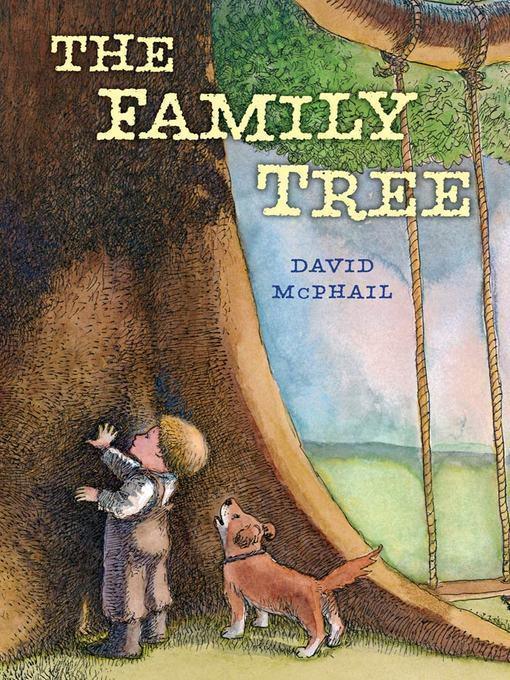
The Family Tree
فرمت کتاب
ebook
تاریخ انتشار
2012
Lexile Score
540
Reading Level
0-1
ATOS
1.8
Interest Level
K-3(LG)
نویسنده
David McPhailشابک
9781466808836
کتاب های مرتبط
- اطلاعات
- نقد و بررسی
- دیدگاه کاربران
نقد و بررسی

January 30, 2012
The continuity of family and nature and the power of a single voice resonate in McPhail’s (The Abandoned Lighthouse) thoughtful fable. Riding in a covered wagon, a man arrives in the wilderness “to start a new life.” He chops down trees to create pastures for his animals, fields for his crops, and logs for his house, but he leaves one tree standing to provide shade in summer and act as a buffer against winter winds. McPhail’s understated, homespun watercolor-and-ink illustrations effectively portray the passage of time, as cars replace horses on the road near the tree. The day finally comes when workers arrive to widen the road—and fell the tree. The original settler’s great-great-grandson, a small boy in overalls, resolutely stands in front of the tree in protest: “Not this tree.” Soon, the boy is joined by a bevy of forest animals; together they stare down the workers, who relent and reroute the road around the tree. A sentimental but inspirational tale. Ages 4–8. Agent: Faith Hamlin, Sanford J. Greenburger Associates.

January 1, 2012
The love of an ancient tree leads a boy to unlikely activism. When the pioneers cleared the land to settle the western wilderness, one young man decided to leave one special tree standing to shade his new home. The years go by, and the land is further developed, but the tree remains, until a proposed highway threatens it. The great-grandson of the original settler calls on animals to help save the tree. Young environmentalists will cheer when the tree is saved, and they will enjoy the family story. McPhail's familiar watercolor-and-ink spreads capture the bucolic setting, especially effective when showing the wide swath of cleared land while the oxen are helping to build the house. Right from the start, though, the tone of the book is muddled by confusing and redundant graphic elements. Speech bubbles seem oddly out of place in the 1800s, especially when the main character is speaking to no one and the narration is clear and complete. The final illustration shows the boy, triumphantly swinging from his beloved tree--but the proximity of the new highway and the vehicular traffic makes this victory seem hollow at best. The graveyard at the right edge seems to indicate the fight against progress may be futile. Classes studying ecology and activism might find something to discuss here. Good intentions; confusing execution. (Picture book. 5-8)
(COPYRIGHT (2012) KIRKUS REVIEWS/NIELSEN BUSINESS MEDIA, INC. ALL RIGHTS RESERVED.)

March 1, 2012
K-Gr 4-Visually told through priceless, historically revealing watercolor and ink illustrations, and voiced with succinct sentences and brief speech bubbles, this picture book chronicles five generations and their "family tree." The title-page illustration depicts an aerial view of a covered wagon entering a forest of dense treetops. Therein, a pioneer stops and starts chopping trees to create a clearing. But he stops, and ponders, "Hmm...not this one." He leaves one tree standing to "provide shade for this house during the long hot summers and act as a buffer against chilly winter winds." Others he uses to make planks, boards, beams, fences, posts, and rails. His oxen help him raise his house. "New generations join the family. Old ones left." Roads are being widened, and workers come to say, "The tree [is] in the way." The great-great-grandson stands in front of it in protest. A bird call goes out, and all the animals that live there join the effort. In what is a true illustrative tour de force, with superb pacing, children see the results of the workers' huddle to find a solution. Pair this stunning book with Virginia Lee Burton's The Little House (Hougton Mifflin, 1942) and Bonnie Pryor's The House on Maple Street (Morrow, 1987) for an eye-opening program on change and ecological awareness.-Sara Lissa Paulson, American Sign Language and English Lower School PS 347, New York City
Copyright 2012 School Library Journal, LLC Used with permission.

March 1, 2012
Preschool-G In this gently observed tale, a young boy saves a large tree that has shaded his family's home for several generations from the encroachment of an adjacent road. Woodland animals join the boy, and the group surrounds the tree and refuses to move when the workmen approach. A solution is worked out, and the final pages show the tree intact with a wide curve in the busy four-lane road allowing plenty of space for the tree. Using a brown-toned palette and loosely sketched figures, McPhail creates a charming, uncomplicated environment populated with sweet-tempered characters. The more literal-minded reader will wonder about the quantum leap from covered wagons to automobiles in a short span of pages and where the protective woodland animals come from, since there don't seem to be any woods left in the area. But plenty will be enchanted by the drawings and the fact that the animals join together and win. Karen Gray Ruelle's The Tree (2008) also follows a tree throughout the generations.(Reprinted with permission of Booklist, copyright 2012, American Library Association.)

























دیدگاه کاربران